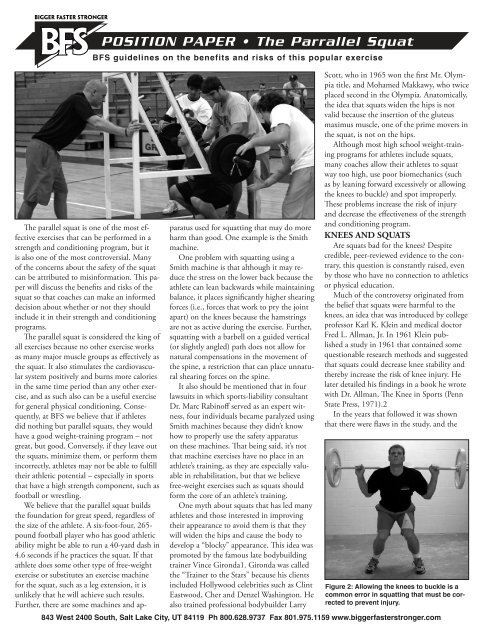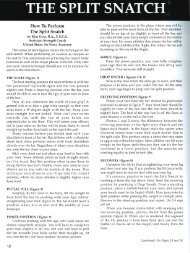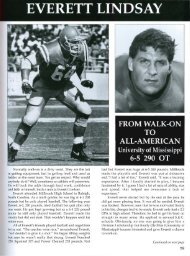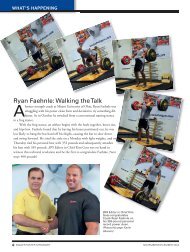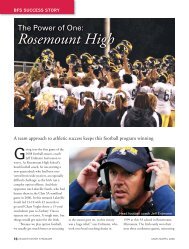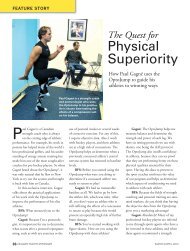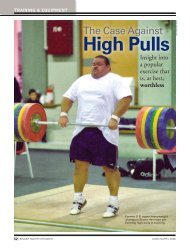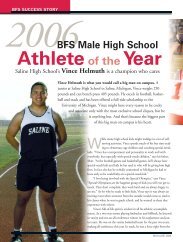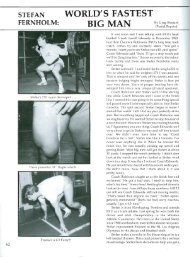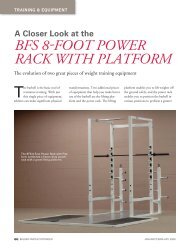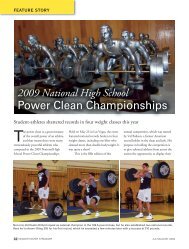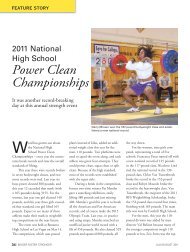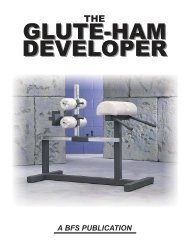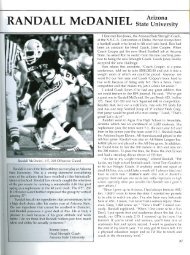POSITION PAPER • The Parrallel Squat - Bigger Faster Stronger
POSITION PAPER • The Parrallel Squat - Bigger Faster Stronger
POSITION PAPER • The Parrallel Squat - Bigger Faster Stronger
You also want an ePaper? Increase the reach of your titles
YUMPU automatically turns print PDFs into web optimized ePapers that Google loves.
<strong>The</strong> parallel squat is one of the most effective<br />
exercises that can be performed in a<br />
strength and conditioning program, but it<br />
is also one of the most controversial. Many<br />
of the concerns about the safety of the squat<br />
can be attributed to misinformation. This paper<br />
will discuss the benefits and risks of the<br />
squat so that coaches can make an informed<br />
decision about whether or not they should<br />
include it in their strength and conditioning<br />
programs.<br />
<strong>The</strong> parallel squat is considered the king of<br />
all exercises because no other exercise works<br />
as many major muscle groups as effectively as<br />
the squat. It also stimulates the cardiovascular<br />
system positively and burns more calories<br />
in the same time period than any other exercise,<br />
and as such also can be a useful exercise<br />
for general physical conditioning. Consequently,<br />
at BFS we believe that if athletes<br />
did nothing but parallel squats, they would<br />
have a good weight-training program – not<br />
great, but good. Conversely, if they leave out<br />
the squats, minimize them, or perform them<br />
incorrectly, athletes may not be able to fulfill<br />
their athletic potential – especially in sports<br />
that have a high strength component, such as<br />
football or wrestling.<br />
We believe that the parallel squat builds<br />
the foundation for great speed, regardless of<br />
the size of the athlete. A six-foot-four, 265pound<br />
football player who has good athletic<br />
ability might be able to run a 40-yard dash in<br />
4.6 seconds if he practices the squat. If that<br />
athlete does some other type of free-weight<br />
exercise or substitutes an exercise machine<br />
for the squat, such as a leg extension, it is<br />
unlikely that he will achieve such results.<br />
Further, there are some machines and ap-<br />
<strong>POSITION</strong> <strong>PAPER</strong> <strong>•</strong> <strong>The</strong> <strong>Parrallel</strong> <strong>Squat</strong><br />
BFS guidelines on the benefits and risks of this popular exercise<br />
paratus used for squatting that may do more<br />
harm than good. One example is the Smith<br />
machine.<br />
One problem with squatting using a<br />
Smith machine is that although it may reduce<br />
the stress on the lower back because the<br />
athlete can lean backwards while maintaining<br />
balance, it places significantly higher shearing<br />
forces (i.e., forces that work to pry the joint<br />
apart) on the knees because the hamstrings<br />
are not as active during the exercise. Further,<br />
squatting with a barbell on a guided vertical<br />
(or slightly angled) path does not allow for<br />
natural compensations in the movement of<br />
the spine, a restriction that can place unnatural<br />
shearing forces on the spine.<br />
It also should be mentioned that in four<br />
lawsuits in which sports-liability consultant<br />
Dr. Marc Rabinoff served as an expert witness,<br />
four individuals became paralyzed using<br />
Smith machines because they didn’t know<br />
how to properly use the safety apparatus<br />
on these machines. That being said, it’s not<br />
that machine exercises have no place in an<br />
athlete’s training, as they are especially valuable<br />
in rehabilitation, but that we believe<br />
free-weight exercises such as squats should<br />
form the core of an athlete’s training.<br />
One myth about squats that has led many<br />
athletes and those interested in improving<br />
their appearance to avoid them is that they<br />
will widen the hips and cause the body to<br />
develop a “blocky” appearance. This idea was<br />
promoted by the famous late bodybuilding<br />
trainer Vince Gironda1. Gironda was called<br />
the “Trainer to the Stars” because his clients<br />
included Hollywood celebrities such as Clint<br />
Eastwood, Cher and Denzel Washington. He<br />
also trained professional bodybuilder Larry<br />
Scott, who in 1965 won the first Mr. Olympia<br />
title, and Mohamed Makkawy, who twice<br />
placed second in the Olympia. Anatomically,<br />
the idea that squats widen the hips is not<br />
valid because the insertion of the gluteus<br />
maximus muscle, one of the prime movers in<br />
the squat, is not on the hips.<br />
Although most high school weight-training<br />
programs for athletes include squats,<br />
many coaches allow their athletes to squat<br />
way too high, use poor biomechanics (such<br />
as by leaning forward excessively or allowing<br />
the knees to buckle) and spot improperly.<br />
<strong>The</strong>se problems increase the risk of injury<br />
and decrease the effectiveness of the strength<br />
and conditioning program.<br />
KNEES AND SQUATS<br />
Are squats bad for the knees? Despite<br />
credible, peer-reviewed evidence to the contrary,<br />
this question is constantly raised, even<br />
by those who have no connection to athletics<br />
or physical education.<br />
Much of the controversy originated from<br />
the belief that squats were harmful to the<br />
knees, an idea that was introduced by college<br />
professor Karl K. Klein and medical doctor<br />
Fred L. Allman, Jr. In 1961 Klein published<br />
a study in 1961 that contained some<br />
questionable research methods and suggested<br />
that squats could decrease knee stability and<br />
thereby increase the risk of knee injury. He<br />
later detailed his findings in a book he wrote<br />
with Dr. Allman, <strong>The</strong> Knee in Sports (Penn<br />
State Press, 1971).2<br />
In the years that followed it was shown<br />
that there were flaws in the study, and the<br />
Figure 2: Allowing the knees to buckle is a<br />
common error in squatting that must be corrected<br />
to prevent injury.<br />
843 West 2400 South, Salt Lake City, UT 84119 Ph 800.628.9737 Fax 801.975.1159 www.biggerfasterstronger.com
Caption: It is a myth that squats will make<br />
the hips wider and create a “blocky” appearance<br />
because the gluteus max imus muscle<br />
does not insert on the hips. Shown are Jesse<br />
Butterfield (top) and Chloe Van Tussenbroek<br />
(btm), multi-sport athletes who have competed<br />
in the School Age National Weightlifting<br />
Championships. Jesse went on to become a<br />
professional model.<br />
results could not be reproduced. Further,<br />
other studies showed exactly opposite results;<br />
namely, that weightlifters and powerlifters<br />
tended to possess tighter knee joints than<br />
control groups and were less susceptible to<br />
knee injuries. What is interesting is that<br />
Klein and Allman did not disapprove of<br />
parallel squats, which are recommended by<br />
BFS, but full squats as performed by Olympic<br />
lifters. However, few people have actually<br />
read Klein and Allman’s book, which says<br />
that parallel squats are fine and have benefits<br />
to athletic performance.<br />
In the years that followed, weightlifters,<br />
powerlifters and sport scientists were eventually<br />
able to convince the medical community<br />
and lay public that squats were not harmful<br />
to the knees and that competitive weightlifters<br />
and powerlifters did not have greater<br />
levels of knee instability than other athletes<br />
or the untrained population3,4. Further,<br />
we at BFS contend that performing squats<br />
by descending under complete control to<br />
achieve a parallel position results in many<br />
positive changes, such as the following:<br />
<strong>•</strong> <strong>The</strong> lower-body muscles become stronger<br />
and bigger, especially the quadriceps and<br />
hamstrings.<br />
<strong>•</strong> <strong>The</strong> tendons become thicker and stronger.<br />
<strong>•</strong> <strong>The</strong> knee ligaments become thicker and<br />
stronger.<br />
<strong>•</strong> <strong>The</strong> entire articular capsule of the knee<br />
becomes thicker.<br />
<strong>•</strong> <strong>The</strong> bones of the legs become stronger<br />
and slightly bigger because of increased capillarization.<br />
<strong>•</strong> <strong>The</strong> cartilage of the knee becomes more<br />
resistant to injury.<br />
<strong>The</strong>se positive effects explain why athletes<br />
who do squats correctly have far fewer<br />
knee injuries than those who do not squat<br />
at all. Including squats in their program<br />
and performing them properly is especially<br />
important for female athletes, because they<br />
are up to five times more likely to suffer<br />
knee injuries than men are in sports such as<br />
basketball and volleyball. According to the<br />
American Orthopedic Society for Sports<br />
Medicine, each year approximately 20,000<br />
high school girls suffer serious knee injuries,<br />
most involving the anterior cruciate ligament,<br />
which helps stabilize the knee.<br />
Proper squatting technique offers athletes<br />
the best defense against knee injuries. That<br />
being said, deep squats can present some<br />
danger to the knee joint, especially if the<br />
lifter comes down fast, is out of control or<br />
bounces at the bottom position. Common<br />
sense tells us that a football player who does<br />
deep squats with, say, 400 pounds is asking<br />
for problems if he comes down hard and<br />
bounces at the deep bottom position. But<br />
if an athlete lifting the same weight comes<br />
down under control to the parallel-squat<br />
position and then comes up, the knee joint<br />
should be in no danger whatsoever.<br />
SQUAT DEPTH<br />
Understanding the importance of depth<br />
in squats is imperative. We base our standards<br />
on a parallel depth or slightly below<br />
it. <strong>The</strong> high school All American standard is<br />
500 pounds for males with heavy builds and<br />
325 pounds for females with heavy builds.<br />
<strong>The</strong> all-state standard is 400 pounds for<br />
males and 235 pounds (think two plates and<br />
a collar) for females. BFS set those standards<br />
to help athletes and coaches understand<br />
when an athlete achieves something remarkable.<br />
Only an exceptional athlete with special<br />
understanding of how to do squats can reach<br />
those standards. If an athlete squats a foot<br />
high, or three inches high with 500 pounds,<br />
it is meaningless. Not a whole lot is really<br />
happening, and the athlete will miss out on<br />
great benefits.<br />
<strong>The</strong> guiding principle in squatting is that<br />
it’s necessary to squat so that the tops of the<br />
upper thighs are at least horizontal to the<br />
floor so that the hamstrings and gluteal muscles<br />
are strongly activated. If you don’t squat<br />
low enough, you only activate the quadriceps<br />
(front thigh muscles). It is our understanding<br />
that if an athlete does not squat low enough,<br />
this reduced muscle recruitment will not<br />
improve knee stability and may even decrease<br />
knee stability by creating muscle imbalances.<br />
And it should be noted that peer-reviewed<br />
research suggests that squatting to parallel<br />
does not increase the stress on the patellofemoral<br />
joint compared to squatting above<br />
parallel.5 Finally, squatting to parallel is<br />
necessary to allow for a natural movement of<br />
the sacroiliac (SI) joint. Improper function<br />
of the SI joint is associated with many types<br />
of lower back pain.6<br />
At BFS, we offer a simple test to help<br />
athletes and coaches determine the proper<br />
depth. It’s called the marble test (Figure 1). If<br />
an athlete were to place an imaginary marble<br />
(or dowel) on the middle of the top of the<br />
thighs during their deepest squat position,<br />
which way would the marble roll? If the<br />
marble would roll towards the knees, the<br />
athlete is not squatting low enough. If the<br />
marble would stay stationary or roll towards<br />
the lifter’s hips, the depth is fine. What you’ll<br />
find by using this standard is that the bottom<br />
of the thighs has to be below parallel at the<br />
bottom of the squat. <strong>The</strong> marble test is better<br />
843 West 2400 South, Salt Lake City, UT 84119 Ph 800.628.9737 Fax 801.975.1159 www.biggerfasterstronger.com
Figure 3: Examples of great spotting by high school athletes<br />
than judging the position of the bottom of<br />
the thigh, as athletes with large legs would be<br />
required to squat considerably lower (Figure<br />
2).<br />
Does BFS have any problem with an athlete<br />
squatting lower than parallel? Certainly<br />
not. All we are saying is that an athlete must<br />
squat to at least parallel to effectively work<br />
the hamstrings. As for the sport of powerlifting,<br />
the extraordinarily high poundages lifted<br />
by many of today’s powerlifters suggest that<br />
there has been considerable leniency among<br />
some organizations as to what parallel is,<br />
along with the supportive gear that can often<br />
add hundreds of pounds to a powerlifter’s<br />
best result in this exercise. Further, the<br />
hyper-wide stance used by many powerlifters,<br />
which reduces the forward movement of<br />
the knees and minimizes the involvement of<br />
the quadriceps, is not the athletic stance that<br />
BFS believes would have the best carryover<br />
to athletics. Another way to think about this<br />
is to say that powerlifters are trying to lift<br />
the heaviest weight possible over the shortest<br />
distance possible, whereas at BFS we are<br />
trying to lift in such a manner as to have the<br />
best carryover to athletics.<br />
Because Olympic weightlifters squat all<br />
the way down, and in competition actually<br />
bounce out of the bottom position, why<br />
doesn’t BFS recommend this style? After all,<br />
knee injuries to competitive weightlifters are<br />
rare, especially compared to knee injuries in<br />
other sports. What is wrong with going all<br />
the way down?<br />
If an athlete has a qualified Olympic lifting<br />
coach to work with them on this squatting<br />
method and the coach believes this form<br />
of squatting is superior, fine. <strong>The</strong> problem is<br />
when an athlete squats all the way down and<br />
relaxes, the knee joint opens up slightly, subjecting<br />
the connective tissues to stress levels<br />
higher than their tensile strength. In the case<br />
of weightlifters, who perform snatches and<br />
cleans bouncing out of the bottom position,<br />
the stress does not become excessive because<br />
they perform these lifts while keeping the<br />
muscles under tension.<br />
Nevertheless, the reality is that a coach<br />
in high school may have 50 kids to work<br />
with at the same time, and it is difficult for<br />
any strength coach to give the one-on-one<br />
attention this type of squatting deserves,<br />
particularly in light of the fact that there<br />
are relatively few qualified Olympic lifting<br />
coaches in this country. Further, it’s not so<br />
much that squatting deep injures the knees<br />
but that it places the lower back at a higher<br />
risk of injury.<br />
Unless an athlete has exceptional flexibility<br />
and proper supervision, what often<br />
happens when an athlete squats all the way<br />
down is that their lower back will round.<br />
Rounding places high, unnatural stresses on<br />
the lower vertebrae of the back (L3, L4 and<br />
L5). Further, this stress is compounded by<br />
the compression forces on the spine, which<br />
are estimated to be six times greater at the<br />
bottom of a full squat than at the top (so<br />
that an athlete squatting 200 pounds would<br />
have 1,200 pounds of compression forces at<br />
the bottom).<br />
Likewise, using a flat or tail-under back<br />
posture (as is often taught in fitness classes<br />
to supposedly increase the involvement of<br />
the glutes) places excessive strain on the<br />
supportive tissues of the lower back. In his<br />
book Facts and Fallacies of Fitness7, the<br />
late Mel Siff warned against this technique:<br />
“Keeping the back ‘flat’ is common advice<br />
in the gymnasium training environment, yet<br />
its validity is rarely questioned. Actually, a<br />
flat back devoid of any curvature is not only<br />
virtually impossible for a normal person to<br />
achieve, but it also reduces the ability of the<br />
spine to absorb or distribute shock and stress<br />
effectively. <strong>The</strong> healthy spine is meant to<br />
have several different curvatures, whereas the<br />
Figure 4: <strong>The</strong> publication of <strong>The</strong> Knee in<br />
Sports in 1961, written Karl K. Klein and<br />
medical doctor Fred L. Allman, led to many<br />
misconceptions about the safety of the squat<br />
exercise.<br />
straight spine suggests the presence of a specific<br />
type of pathology.” Again, if an athlete<br />
has exceptional flexibility and one-on-one<br />
coaching from a qualified Olympic lifting<br />
coach, it would be better to go with a parallel<br />
squat, or slightly below.<br />
Next, there is the mistaken belief that<br />
squats invite adverse effects on the cardiovascular<br />
system because they cause a rise in<br />
blood pressure. It is true that blood pressure<br />
rises, but the effect is only temporary and<br />
the heart adapts positively to this stress by<br />
hypertrophying the left ventricle. It should<br />
also be noted that leg presses performed on a<br />
45-degree angle increase the blood pressure<br />
significantly more than squats do. Of course,<br />
if an athlete has any cardiovascular issues,<br />
they must consult with their private health<br />
care practitioner about the effects that squats<br />
will have on their condition.<br />
Finally, there is the argument that squatting<br />
all the way down doesn’t work the quads<br />
and hamstrings throughout the full range of<br />
motion. That’s true, but that’s why BFS has<br />
Figure 5: A dowel can be used to help determine<br />
the proper depth of a squat.<br />
843 West 2400 South, Salt Lake City, UT 84119 Ph 800.628.9737 Fax 801.975.1159 www.biggerfasterstronger.com
Figure 6: Lifters with large thighs will have<br />
difficulty reaching parallel if the bottom of the<br />
thighs were used to determine parallel.<br />
made glute-ham raises and lunges high-priority<br />
auxiliary exercises. Both of these exercises<br />
put minimal stresses on the lower back while<br />
working the quads, especially the vastus medialis<br />
(an inner thigh muscle that crosses the<br />
knee joint and is therefore key to maintaining<br />
knee stability) and all four heads of the<br />
hamstrings.<br />
PRESQUAT TECHNI QUE<br />
Before squatting, you must be certain to<br />
have the proper equipment. It’s best to squat<br />
inside a power rack, with safety pins adjusted<br />
to the proper height. However, the safety<br />
pins should be thought of as more “depth<br />
control,” that is, a last-resort method of ensuring<br />
the safety of the athlete, as dropping<br />
any barbell on these pins from more than<br />
a few inches can easily damage the barbell.<br />
Also, it’s better to use Olympic barbells<br />
that have center knurling, to more properly<br />
secure the weight on the shoulders, and a<br />
stiffer barbell. <strong>The</strong> more flexible (and more<br />
expensive) Olympic bars are great for power<br />
cleans, but that same flexibility makes it difficult<br />
to control the barbell during a squat.<br />
When you are ready to squat, you must<br />
make several important technique preparations<br />
– getting a secure grip, properly<br />
positioning the bar on the shoulders, and<br />
removing the barbell from the rack.<br />
GRIP. Two technique guidelines will help<br />
you establish a proper grip on the squat. First<br />
is thumb position. Should you have your<br />
thumb around the bar or behind the bar?<br />
About 60 percent of power lifters have the<br />
thumb in back, and 40 percent prefer their<br />
thumbs around the bar. Obviously, both<br />
styles are acceptable, but larger athletes or<br />
those with flexibility issues usually prefer that<br />
my athletes lift with their thumbs behind the<br />
bar as this grip makes it easier to push the<br />
elbows forward and lock in the lower back.<br />
<strong>The</strong> second grip guideline to consider is<br />
the width of the grip. At clinics our coaches<br />
ask those attending to pretend that they have<br />
a bar on their shoulders and to get a “very<br />
narrow grip.” <strong>The</strong>n, we ask them to sit tall,<br />
spread their chests, and lock in their lower<br />
backs. Next, we tell them to change to a wide<br />
grip and lock in their lower backs. When we<br />
ask them what grip makes it easier to lock<br />
in the lower back, unanimously they always<br />
respond that it’s the wide grip.<br />
Make certain to use the lines grooved into<br />
most Olympic bars about four inches from<br />
the inside collars. Use these lines as reference<br />
points. For example, you might put your first<br />
finger on each line with your thumbs behind<br />
the bar. Now you are properly balanced with<br />
a wide grip and have some assurance that the<br />
bar will remain secure on your shoulders.<br />
You are now ready to place the bar on your<br />
shoulders. Figure 00 illustrates the proper<br />
way to grip.<br />
BAR <strong>POSITION</strong>. A common mistake<br />
for athletes who squat is placing the bar too<br />
high on the shoulders. In fact, many athletes<br />
place the bar right on the neck. That hurts,<br />
so they’ll use a barbell pad. Most athletes can<br />
squat with more weight, greater effectiveness,<br />
and more comfort by placing the bar lower<br />
on the shoulders. Structural differences in<br />
bone length and tendon-muscle attachments<br />
may allow some athletes to squat more effectively<br />
with high bar placement.<br />
Some power lifters place the bar extremely<br />
low on the shoulders, perhaps as much as<br />
four inches from the top of the shoulders.<br />
This method may give a slight anatomical<br />
advantage, or the advantage may result from<br />
using a heavy, tight lifting suit or even from<br />
a lack of flexibility. Whatever the reason,<br />
squatting using extremely low bar placement<br />
detracts from overall leg development, which<br />
is obviously not helpful to the athlete.<br />
Most athletes will be able to find a natural<br />
groove on the shoulders when they come<br />
under the bar in a proper position. If an athlete<br />
is experiencing neck or upper back pain<br />
from squats, it may be because the barbell is<br />
improperly position on the shoulders or they<br />
are performing the exercise improperly. We<br />
tell them, “Don’t put the bar on your neck;<br />
put it on your shoulders. Find a groove.”<br />
In almost every case, if a coach voices these<br />
technique cues, athletes will achieve excellent<br />
bar placement during their squats.<br />
If an athlete does not rapidly adjust<br />
to squatting with a barbell on their back,<br />
they should consider attaching a Manta<br />
Ray device to the barbell. <strong>The</strong> Manta Ray<br />
spreads the pressure of the barbell over a<br />
wider area, a change that makes performing<br />
the exercise more comfortable. <strong>The</strong>re is only<br />
one size Manta Ray available, but the only<br />
individuals who might have a problem using<br />
it are those with exceptionally large trapezius<br />
development.<br />
REMOVING THE BAR FROM THE<br />
RACK. We’ve seen high school athletes get<br />
all psyched up to squat and then position<br />
their shoulders two to three inches under<br />
the bar. Next, with an explosive movement,<br />
they jam their shoulders against the bar.<br />
Well, jamming their shoulders against a steel<br />
bar from that distance causes bruises on the<br />
necks or shoulders. Besides feeling pain,<br />
these athletes often place the bar on their<br />
shoulders incorrectly. We’ve also seen athletes<br />
whip a bar off the rack. Many times these<br />
athletes are not in solid squatting position as<br />
they back up to a ready stance. For those reasons,<br />
the few injuries that take place during<br />
squatting most often occur while the athlete<br />
is taking the bar off the rack or replacing it<br />
on the rack, not during the squat exercise<br />
itself.<br />
A far superior way to handle the bar is<br />
to come under it in a solid power position,<br />
making sure that everything is correct. To<br />
accomplish this, get the bar in the groove<br />
on your shoulders. Look straight ahead and<br />
spread the chest. <strong>The</strong> next technique point is<br />
critical. Get into your athletic stance directly<br />
under the bar. Many athletes stand a foot<br />
back and lean forward. Taking that position<br />
can cause lower-back trouble, especially with<br />
heavy weight. Now you’re ready. Put some<br />
pressure on the bar and make sure that everything<br />
feels right. If it does, blast off! This<br />
explosive movement will not bruise your<br />
shoulders because you’ve already put some<br />
pressure on the bar. Because of your explosive<br />
movement from the correct position, the<br />
bar feels light. You are confident.<br />
<strong>The</strong> bar is now off the rack, and you are<br />
firmly under the weight. At this point, take a<br />
short step back with each foot and resume an<br />
athletic stance. You are ready to squat. With<br />
some squat racks, you may have to take several<br />
steps backward to clear yourself to squat.<br />
Some step-squat racks and peg-squat racks<br />
may require many long steps for clearance.<br />
Some squat racks have a spotting tier that is<br />
too high for parallel squats, thus requiring a<br />
long walk back to reach the correct position.<br />
Obviously, you are at a disadvantage if you<br />
have to do anything more than take a short<br />
step back with each foot.<br />
Regarding foot stance, having the feet<br />
pointed slightly outward enables the quadriceps<br />
are able to contract more forcefully and<br />
increases the involvement of the adductors.<br />
843 West 2400 South, Salt Lake City, UT 84119 Ph 800.628.9737 Fax 801.975.1159 www.biggerfasterstronger.com
Ideal foot position varies with an individual’s<br />
anatomy, but whatever position the athlete<br />
uses he or she must make certain that the<br />
knees are aligned with the feet.<br />
SQUAT TECHNIQUE<br />
<strong>The</strong> parallel squat can be a tricky lift.<br />
Technique and correct position mean everything.<br />
You must execute every technique<br />
guideline to perfection when attempting a<br />
new max. You must be psyched, but it must<br />
be a controlled psych. Now, on to the squat.<br />
<strong>The</strong> squat has four main phases: the start,<br />
the descent, the bottom position, and the<br />
upward drive. You must concentrate on perfect<br />
technique during all parts of the squat to<br />
achieve maximum results.<br />
START. You should be looking straight<br />
ahead at a target. Your mind should be clear<br />
and intense, thinking about technique:<br />
spreading the chest, locking in the lower<br />
back, and performing your descent pattern.<br />
You must take a huge breath and hold it just<br />
before the descent. For a one-rep max, take<br />
two breaths-first, a huge breath you hold to<br />
let the air settle deep within the rib cavity,<br />
and second, a quick breath as you begin the<br />
descent to expand the chest even further.<br />
DESCENT. You should descend in an<br />
even, controlled pattern. Some athletes descend<br />
inch by inch and take forever, which is<br />
a mistake. Some athletes rapidly crash down<br />
out of control, which is dangerous. By using<br />
an even, controlled pattern, your technique<br />
will likely be better. Throughout the descent,<br />
you should hold your breath. Always spread<br />
the chest, lock in the lower back, look at<br />
your target, and sit tall (figure 3).<br />
BOTTOM <strong>POSITION</strong>. You should<br />
squat to the parallel position or slightly<br />
below it. Keep in mind that many athletes<br />
squat high, a common flaw that will detract<br />
from their performance. By adhering strictly<br />
to the parallel position, you will have an<br />
advantage in competition. If you squat high,<br />
only minimal hamstring or glute development<br />
will take place, which will limit your<br />
improvement in speed and jumping. Hitting<br />
a correct parallel position is critical for personal<br />
and team success. It is one of the great<br />
secrets in this book.<br />
Some football and strength coaches want<br />
their athletes to break parallel. We no objection<br />
to this whatsoever. <strong>The</strong> bottom line is<br />
that to get proper leg development, athletes<br />
must go at least to parallel. Some coaches<br />
use the bottom of the thigh, not the top of<br />
the thigh, as their parallel-squatting reference<br />
point. This method creates problems<br />
because many athletes with large thighs end<br />
up squatting two or three inches higher than<br />
they would if they used the top of the thigh<br />
as the parallel point. <strong>The</strong>se athletes will forgo<br />
hamstring and glute development; in addition,<br />
standards become meaningless.<br />
UPWARD DRIVE. You should continue<br />
holding your breath when beginning the<br />
upward drive from the parallel position. You<br />
should picture your hips attached to a giant<br />
rubber band. As you go down to parallel,<br />
you stretch the rubber band to the limit. <strong>The</strong><br />
instant your hips hit parallel, you release the<br />
rubber band. Your hips pop upward while<br />
you maintain perfect technique.<br />
About halfway up, you pass through<br />
the sticking point, the position at which<br />
the squat becomes easier. When you reach<br />
the sticking point, you should breathe out.<br />
Athletes performing a heavy squat will<br />
sometimes let out a yell as they expel the air<br />
in their lungs. This is perfectly acceptable<br />
and probably helps with the overall psych of<br />
the lift.<br />
Your eyes should remain fixed on the same<br />
point throughout the entire upward drive.<br />
When you complete the set, take short, controlled<br />
steps back to the rack. Always remain<br />
in a solid position as you rack the bar.<br />
SOLVING SQUATTING PROBLEMS<br />
Three common mistakes in squatting include<br />
knees in and knees forward, and lifting<br />
your hips too early. <strong>The</strong> knees-in problem is<br />
more difficult to correct and puts unwanted<br />
pressure on the medial collateral ligament.<br />
This problem is quite common among<br />
female athletes and boys of junior high age.<br />
When squatting, the knees-in problem will<br />
surface on the way up. <strong>The</strong> knees are usually<br />
all right on the way down when squatting.<br />
<strong>The</strong> first step is for the coach to yell,<br />
“Knees!” to the athlete who is squatting. This<br />
is a signal for the athlete to force the knees<br />
out over the toes.<br />
This signal may not work the first time. If<br />
it doesn’t, a second correction technique is<br />
to tap the inside of the athlete’s knee lightly.<br />
This gives the athlete a kinesthetic feel of<br />
the problem. <strong>The</strong> cure usually happens after<br />
only a few light taps. If the problem persists,<br />
coaches should videotape their athletes performing<br />
squats so that they can see themselves.<br />
This usually does the trick in those<br />
few extreme cases.<br />
<strong>The</strong> knees-forward problem often occurs<br />
with beginners who lift their heels off the<br />
ground during the descent. This error puts<br />
harmful stress on the patella area, besides<br />
causing the lift to be horribly ineffective.<br />
Coaches can correct the knees-forward<br />
problem by letting the athlete hold on to a<br />
partner’s hands for balance, which we call<br />
the squat balance test (Figure 4). <strong>The</strong> athlete<br />
should sit tall, spread the chest, and keep the<br />
elbows and shoulders back. <strong>The</strong> athlete will<br />
then be able to balance with the heels on the<br />
ground from a parallel-squat position. <strong>The</strong><br />
partner should let go after a while to let the<br />
athlete have a chance to regain balance from<br />
that difficult position.<br />
Surprisingly, most high school athletes<br />
can balance themselves after they get the feel<br />
of the parallel position with their heels on<br />
the ground. Many bodybuilders squat with<br />
the knees forward and the bar positioned<br />
high on the neck. <strong>The</strong>y usually lift with a<br />
lighter weight and higher reps, along with<br />
substituting other exercises for squats such as<br />
the leg press, and therefore may never have a<br />
problem. Athletes, however, usually bring the<br />
bar back more on the shoulders and want to<br />
lift a lot more weight. If the knees continue<br />
to come forward with heavier weights, this<br />
can be a potentially dangerous situation. <strong>The</strong><br />
athlete must attempt to sit back more on the<br />
hips, with the lower leg being more vertical.<br />
Sometimes, especially with a heavy<br />
weight, your hips may come up all right but<br />
you will lean over. To correct this position,<br />
you can try two techniques. First, scoot your<br />
hips forward and try to get them underneath<br />
the bar. Obviously, you should reexamine<br />
our previous technique guidelines for the<br />
chest and lower back. <strong>The</strong> second technique<br />
that works extremely well with many athletes<br />
is to think “elbows forward.” When you press<br />
your elbows forward during a squat, you<br />
will tend to have an upright torso with a big<br />
chest and a locked-in lower back. <strong>The</strong> hips<br />
will follow the elbows.<br />
SPOTTING<br />
Correct spotting technique is critical to<br />
proper execution of the squat. Coaches have<br />
the responsibility to teach correct spotting<br />
techniques. Three spotters, a back spotter<br />
and two side spotters, should be used to<br />
ensure success in squatting. <strong>The</strong> functions of<br />
the spotters are threefold. First, the spotters<br />
should act as coaches and give correct<br />
technique cues. Second, they should act as<br />
judges on depth and technique problems.<br />
Third, they should be enthusiastic teammates<br />
and offer constant encouragement. Spotters<br />
should pull the best from their training<br />
partners.<br />
Figure 00 shows correct spotting positions<br />
for the parallel squat. <strong>The</strong> side spotters are<br />
in the correct position for their dual role as<br />
843 West 2400 South, Salt Lake City, UT 84119 Ph 800.628.9737 Fax 801.975.1159 www.biggerfasterstronger.com
Figure 7: Weightlifters squat all the way<br />
down, but this depth is not necessary for<br />
most athletes and should only be used under<br />
the guidance of a qualified weightlifting<br />
instructor.<br />
coaches and judges. Notice the position of<br />
the side spotters. One spotter has his head<br />
behind the bar, and the other has his head in<br />
front. Spotters must get into these positions<br />
to judge the parallel squat. <strong>The</strong> side spotters<br />
should be in squat position on the sides with<br />
their hands underneath the bar. If something<br />
happens, it usually happens quickly, and the<br />
spotters need to be ready. Spotters cannot<br />
stand on the sides with their arms crossed.<br />
After the lifter completes the set, the side<br />
spotters grasp the bar and help the lifter back<br />
to the rack.<br />
Spotters need to be vocal in letting their<br />
teammate know how he or she is doing. No<br />
lifter can see or hear a nod of the head. Spot-<br />
ters should encourage their teammate during<br />
and immediately after the set by offering<br />
comments such as “Looking good,” “Great<br />
job,” “Awesome set,” “One more rep,” or<br />
“You can do it.”<br />
<strong>The</strong> back spotter should place his or her<br />
hands firmly on the bar at all times, from<br />
the moment the lifter gets under the bar<br />
to back out to when he or she puts the bar<br />
back on the rack after squatting. <strong>The</strong> back<br />
spotter places his or her hands on the bar<br />
for two reasons. First, the spotter can easily<br />
correct technique, especially when the lifter<br />
leans forward. <strong>The</strong> back spotter just pulls<br />
back slightly but firmly to correct the poor<br />
position. In addition, the back spotter should<br />
talk and encourage the lifter through the lift<br />
and set. Sometimes power lifters spot from<br />
behind with the arms going under the lifter’s<br />
armpits to the chest, but this assumes that<br />
technique problems are absent.<br />
In addition to proper technique, there<br />
is the issue of safety in performing the lift.<br />
Because relatively heavy weights can be used<br />
in the squat, it’s essential that proper spotting<br />
be used. Although it’s possible to squat safely<br />
with one spotter (standing behind the lifter),<br />
we prefer that three spotters be used (two<br />
at the side and one behind). In addition to<br />
spotting, the side spotters can judge spotting<br />
depth and technique and can encourage<br />
the athlete to break personal records. <strong>The</strong><br />
instructional video that is now available on<br />
our website will demonstrate proper spotting<br />
technique.<br />
Finally, proper equipment should be used.<br />
It’s best to squat inside a power rack, with<br />
safety pins adjusted to the proper height.<br />
However, the safety pins should be thought<br />
of as more “death control,” that is, a lastresort<br />
method of ensuring the safety of the<br />
athlete, as dropping any barbell on these<br />
pins from more than a few inches can easily<br />
damage the barbell. Also, it’s better to use<br />
Olympic barbells that have center knurling,<br />
to more properly secure the weight on the<br />
shoulders, and a stiffer barbell. <strong>The</strong> more<br />
flexible (and more expensive) Olympic bars<br />
are great for power cleans, but that same flexibility<br />
makes it difficult to control the barbell<br />
during a squat.<br />
Those are the basics of productive squatting.<br />
If you follow the guidelines closely,<br />
you’ll develop unbelievably strong quads,<br />
glutes, and hamstrings, a combination that<br />
translates into reduced susceptibility to<br />
injury, improved power, and greater athletic<br />
performance.<br />
When BFS started 32 years ago, one<br />
of the most controversial aspects of our<br />
program was our promotion of the squat.<br />
Most of the controversies were a result of<br />
misinformation, which we can now resolve<br />
with scientific research. Our original claim<br />
was that the parallel squat is one of the best<br />
exercises for athletes, and we continue to<br />
stand by it 100 percent.<br />
843 West 2400 South, Salt Lake City, UT 84119 Ph 800.628.9737 Fax 801.975.1159 www.biggerfasterstronger.com


